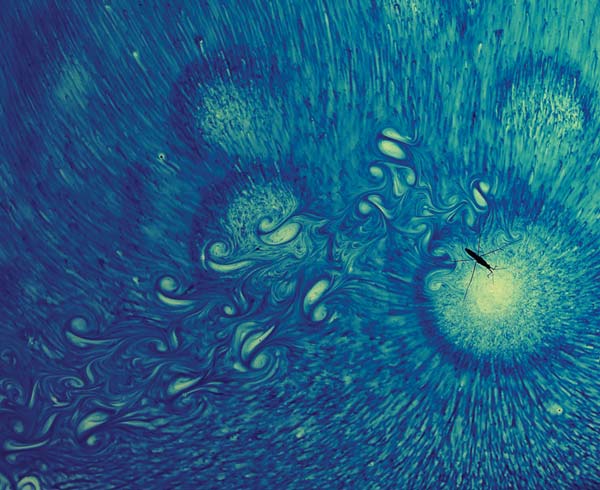Walk on the Water
By Felice Frankel
MIT mathematician John Bush studies the fluid dynamics of water striders
MIT mathematician John Bush studies the fluid dynamics of water striders

DOI: 10.1511/2004.48.366
John Bush is associate professor of applied mathematics at the Massachusetts Institute of Technology. In his research, he uses experimental and theoretical techniques to elucidate fundamental problems in fluid dynamics. I first saw some of John's still photographs of water responding to various forces and since then have paid close attention to his stunning images. I am always delighted to be reminded that research can be presented with both mathematical and visual beauty.

Reprinted by permission from Nature 424:663–666 (2003) copyright 2003 Macmillan Publishers Ltd.
F. F. Can you tell us what brought you to investigating the motion of water striders?
J. B. Much of my recent work in fluid mechanics has been focused on flows dominated by the influence of surface tension. I have long been looking for outstanding problems in the biological sciences in which surface tension is important. When I learned of Denny's paradox—the assertion that infant water striders should be unable to move—I realized that the dynamics of water-walking insects was just such a problem.
F. F. "Denny's paradox?"
J. B. It was generally believed that water striders relied on waves to transfer momentum to the underlying fluid. A standard result from hydrodynamic theory indicates that, in order to generate waves, an object moving at the surface must exceed the minimum wave speed (about 23 centimeters per second at an air-water interface). Infant water striders' peak leg speeds may be less than this critical value. It was thus thought that they would be unable to generate waves, unable to transfer momentum to the underlying fluid, and so unable to move. The fact that infant water striders can move resulted in the conundrum known as Denny's paradox.
F. F. How did you capture this particular still image?
J. B. It was shot by my students (David Hu and Brian Chan) with our standard digital Sony still camera. The 2-centimeter-deep fluid layer was contained within a shallow plexiglass tank placed on a light table, which gave the fluid its apparent luminescence. We were hoping for the strider to follow a straight line, and so leave a linear trail of vortices. The pattern of the thymol blue, the path taken by the strider, and the resulting lines were simply fortuitous. Needless to say, many such photos were taken, but this was our favorite.
F. F. What kind of information do you get from measuring the shape and size of the vortices?
J. B. The form of the vortices, in addition to their speed, indicates the magnitude of the momentum that they transfer. In order for water striders to move, they must transfer momentum to the underlying fluid; it was previously thought that they did so through waves. The point of our study was to show that vortices rather than waves are responsible for the dominant momentum transfer in the wake of the strider.
F. F. Much of your other work captures phenomena through photography. Would you say that you are engaged both visually and mathematically as you first approach a question ... or does the math come later?
J. B. All of my research has its origins in our laboratory, and is focused on elucidating new physical (specifically, fluid mechanical) phenomena. Photography is the simplest means by which to clearly present the flow of interest to the reader. The mathematical modeling is both motivated and constrained by our experimental observations, and the two typically evolve in tandem. However, in my work the mathematical modeling is rarely if ever as elegant as the phenomenon of interest.
Click "American Scientist" to access home page
American Scientist Comments and Discussion
To discuss our articles or comment on them, please share them and tag American Scientist on social media platforms. Here are links to our profiles on Twitter, Facebook, and LinkedIn.
If we re-share your post, we will moderate comments/discussion following our comments policy.